
1.The Brief Introduction of LSE
As the world third largest stock exchange center, London Stock Exchange(LSE) is the world’s oldest stock exchange. It started life on the ground floor of London at the end of 17th century, which was a royal exchange for dealing the government bonds at that time. It moved from the ground floor to Sweeting’s Alley in 1773 and changed the name to “London Stock Exchange” formally. LSE got the formal authorization of British government in 1802. After that, the stock exchanges also came into existence in the other places of UK, over 30 in the Peak time. 7 regional exchanges of UK were organized in 1967. LSE amalgamated with the regional exchanges such as Glasgow, Liverpool, Manchester, Birmingham and Dublin in 1973 and became the U.K. Stock Exchange which was divided into two independent parts in December 1995: one belongs to Ireland, the other belongs to England namely the present LSE. The regional exchanges stopped operation on the later stage of 80’s.
LSE made great merit for the prosperity of British economy at that time, but along with the change of domestic and world economic situation, the strong conservative color especially the bad customs and habits followed blocked the development of British stock market seriously and influenced its competitiveness. Under this situation, LSE carried on a big reform in October 1986 including reforming the fixed system of commission, allowing the big corporations to trade in the exchange directly, loosening the investigation on the qualification of members, allowing wholesalers and brokers to operate in a dual capacity, making all trading performed via computer, connecting with New York and Tokyo, and realizing 24 hours global trading. These measures took a fundamental change to the British stock market, and strengthened its position in the international stock market.
2.The Characteristics of LSE
(1) Have the most varieties of securities, besides stocks, there are also nationalized industrial bonds, government bonds of British Commonwealth and other countries, bonds of local governments, public organizations, industrial and commercial enterprises. Foreign securities account for about 50%:
(2) Have a great deal of funds investing in the international securities. Listing in London means to set up an important connection with the circle of international finance.
(3) It operates four independent trade markets.
3.The Way trading in LSE
(1) List
(2) Issue the bonds
(3) Join SEAQ
4.The conditions listing on LSE
(1) Three years trading record and recent three years general ledger are required. If no 3 years trading record, some scientific and technological industrial Companies, investing entities, mineral industrial companies and companies undertaking the important construction projects can also list so long as they meet the relevant standards of “detailed rules and regulations for listing " of LSE.
(2) administrative level should demonstrate their responsibilities in the trading record of the company.
(3) The financial report should be audited independently according to US GAAP or IFRS.
(4) The registered capital in the domestic exchange should be over £700 thousand and at least 25% of shares should be held by the public. In fact, the total capital stock should be not less than £25 million generally if raise the international capital through LSE.
(5) The company should work out the listing manual according to the standards and requirements of LSE (including the laws of European Community and the laws of financial service, 1986). The sponsor should issue the relevant information in English.
www.ipouk.com Raising Capital in UK |
